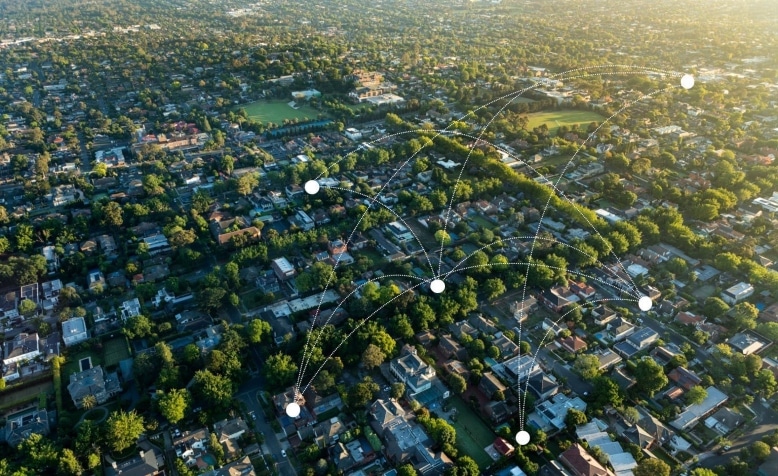Broadband Office Name: Connecticut Department of Energy & Environmental Protection (DEEP) – Office of Telecommunications and Broadband
BEAD Award Amount: $144.2 M
Connecticut Broadband Director: Kevin Pisacich
Website: https://portal.ct.gov/deep/energy/office-of-telecommunications-and-broadband
Connecticut BEAD Program Tracker
| State | IP Vol 1 Approval | IP Vol 2 Approval | Challenge Process Submission Closed | Challenge Process Final Determination Phase Completed | 1-Year Subgrantee Selection Process |
|---|---|---|---|---|---|
| Connecticut | Yes | Yes | Yes | No | Yes |
Connecticut BEAD Program Information

Key Updates
The Challenge Process Submission Phase for Connecticut’s BEAD program ran from April 1 to May 14.
The program’s Rebuttal Phase ran from May 24 to June 22. Following this, the Final Determination Phase took place from June 23 to July 22.
Connecticut now has the NTIA’s approval on its Initial Proposal Volume 2.
Connecticut BEAD Program Plans & Maps
Connecticut BEAD Program Initial Proposal Volume 2: Overview
*Information is subject to change. Connecticut is awaiting official approval of Initial Proposal Volume 2 from the NTIA.
BEAD Long-Term Objectives
Connecticut Department of Energy & Environmental Protection (DEEP) strategic goals and objectives:
Enhance Broadband Deployment
- Goal: Achieve universal access to reliable, high-speed internet.
- Strategy: Utilize the BEAD program and collaborate with other state agencies to develop strategies that increase the highly skilled workforce required for broadband deployment.
Promote Affordability
- Goal: Foster affordable service options.
- Strategy: Increase ACP enrollment, define low-cost/middle-mile affordability service options, and collect data on current service rates and options.
Facilitate Adoption
- Goal: Encourage new entrants in areas with low adoption rates.
- Strategy: Leverage existing state and federal resources and support the development of new programs to overcome adoption barriers.
Increase Network Resiliency and Reliability
- Goal: Identify opportunities to enhance network resiliency and reliability.
- Strategy: Develop a unified strategy for coordinating facility-sharing efforts and reward reliable, future-proof project designs.
Implement the State Digital Equity Plan
- Goal: Identify and assist communities with limited access to resources.
- Strategy: Utilize findings from a comprehensive needs assessment to foster partnerships with local community organizations, educational institutions, municipal, regional, and tribal governments to address the needs of critical populations.
Connecticut BEAD Program Project Area Design
DEEP plans to define broadband project areas based on town boundaries. To ensure comprehensive coverage, DEEP will require applicants to submit proposals that address all or nearly all unserved and underserved locations within these boundaries.
Applicants will have the opportunity to propose projects that encompass entire towns, ensuring that every unserved and underserved address within town limits is included in their proposals. This approach aims to achieve uniform and widespread broadband deployment across Connecticut.
Connecticut BEAD Program Extremely High Cost Threshold
DEEP will develop the EHC using the pricing and associated data provided by applicants through the application process, including feedback and outcomes from the Negotiation Phase of the process.
BEAD Deployment Subgrantee Selection
DEEP is asking for the following preregistration evidence from subgrantees and compliance with: Financial capability, managerial capability, operational capability, technical capability, ownership info, public funding info, compliance with laws, cybersecurity/supply chain compliance, and BABA/EHP/NEPA/NHPA compliance.
Primary Scoring Criteria for Priority Broadband Projects
- 45 pts – Minimal BEAD Outlay
- 15 pts – Affordability
- 15 pts – Labor Standards
Secondary Scoring Criteria
- 1 pt – Speed to Deployment
- 10 pts – Area of High Poverty
- 14 pts – Economic Development Impact
Primary Scoring Criteria for Non-Priority Broadband Projects
- 45 pts – Minimal BEAD Outlay
- 15 pts – Affordability
- 15 pts – Labor Standards
Secondary Scoring Criteria
- 14 pts – Speed of Network and other Technical Capabilities
- 1 pt – Speed to Deployment
- 10 pts – Economic Development Impact
BEAD Non-Deployment Subgrantee Selection
The Connecticut Department of Energy and Environmental Protection (DEEP) has identified potential challenges with its current cost estimates, which may exceed the state’s allocation from the Broadband Equity, Access, and Deployment (BEAD) program. This shortfall could limit DEEP’s ability to fund other state broadband initiatives.
If additional funds become available, DEEP may consider supporting the following initiatives:
- Workforce Training Programs: Developing skills necessary for the broadband industry.
- Digital Literacy and Upskilling: Enhancing digital skills among residents.
- Educational Enhancements: Increasing STEM (Science, Technology, Engineering, and Mathematics) curricula in schools.
- Learning and Telehealth Services: Expanding access to online education and telehealth services.
- Cybersecurity and Digital Safety Training: Offering training on cybersecurity, privacy, and digital safety.
- Digital Equity Plans: Ensuring equal access to digital resources across the state.
- Technical Support Programs: Providing technical assistance to broadband users.
- Multi-lingual Outreach: Making broadband information accessible in multiple languages.
- Prisoner Education: Offering digital education programs for incarcerated individuals.
- Broadband Subscription Subsidies: Providing direct subsidies to help households afford broadband services.
- Stakeholder Engagement Costs: Covering expenses related to engaging with stakeholders.
- Other Necessary Costs: Funding any other allowable costs to support the programmatic activities of the award.
BEAD Eligible Entity Implementation
Connecticut plans to directly manage key activities under the BEAD program without issuing a subgrant. These activities include:
- General Administration of the BEAD Award: Overseeing the overall administration of the BEAD funds.
- Oversight of BEAD Subgrant Applications and Issuance: Managing the application and issuance processes for subgrants.
- Other BEAD Management Processes:
- Implementing the BEAD challenge process.
- Managing the subgrantee application and issuance process.
- Acquiring software to manage these processes.
- Overseeing subgrantee compliance.
Additionally, DEEP may allocate funds to continue its efforts in mapping and data collection to support these activities.
BEAD Local, Tribe, and Regional Broadband Planning Process
This effort is in coordination with DEEP and the Commission for Educational Technology within the Department of Administrative Services (DAS), which is leading the development of the state’s Digital Equity Plan.
Goals:
- Ensure full participation in engagement activities, including those in Tribal, rural, suburban, and urban areas.
- Conduct meaningful outreach to diverse stakeholder groups.
- Establish clear procedures for engagement.
- Utilize several outreach methods.
- Reach out to unserved and underserved communities.
Objectives:
- Establish a process to identify key stakeholders to develop an inclusive long-term model.
- Update the stakeholder engagement process.
- Reconcile any issues raised with BEAD documents.
- Ensure stakeholder engagement efforts are aligned.
Informing and Raising Awareness:
- Set up an email and phone hotline.
- Develop a stakeholder database.
- Provide regular website and digital media updates.
- Engage traditional media through press events and written releases.
- Distribute communications and promotional materials.
BEAD Labor Standards & Protection
DEEP requires all BEAD subgrantees to submit the following information:
A record of past compliance with federal/employment laws:
- Must address info on deployment projects within the last 5 years.
- Certification form from an Officer/Director level employee of past compliance.
- Written confirmation that subgrantee has disclosed any violations from contractors within the last 5 years.
- Discussion of workforce plan
Plans for ensuring compliance with federal/employment laws:
- How subgrantee will ensure compliance in its labor/employment practices.
- Info on applicable wage scales, wage, and overtime practices for each class of employee expected to be involved in physical construction of the network.
- How subgrantee will ensure implementation of workplace safety committees.
- Comply with the Prevailing Wages Act.
- Other items as outlined in the BEAD NOFO.
BEAD Minority Business Enterprises / Women’s Business Enterprises / Labor Surplus Area Firms Inclusion
DEEP is dedicated to fostering partnerships with various organizations to support minority and women-owned business enterprises (MWBEs). Key partnerships include:
- Supplier Diversity Program (SDP)
- Connecticut Department of Economic and Community Development (DECD) Minority Business Initiative (MBI)
- Black Business Alliance
- City of Bridgeport Small & Minority Business Enterprise Department
- City of Hartford Supplier Diversity Program
- City of New Haven Small Contractor Development Program
- Collaboration of Minority Women Professionals
- Greater New England Minority Supplier Development Council
- Southern Connecticut Black Chamber of Commerce
- Women’s Business Development Council
To promote the participation of small, minority, and women-owned businesses, DEEP will take the following affirmative steps:
- Solicitation Lists: Place qualified small and minority businesses and women’s businesses on solicitation lists.
- Direct Solicitation: Ensure these businesses are solicited when they are potential sources.
- Task Division: Divide total requirements into smaller tasks to permit maximum participation by small and minority businesses and women’s business enterprises.
- Delivery Schedules: Establish delivery schedules that encourage participation by small and minority businesses and women’s business enterprises.
- Utilize Support Services: Use the services and assistance of organizations such as the CT Small Business Administration and the Small/Minority Business Center within the Department of Administrative Services.
- Subgrantee Requirements: Require subgrantees to take these affirmative steps concerning their subcontractors.
- Monitor Compliance: Monitor project compliance with the above commitments throughout the BEAD process.
BEAD Cost & Barrier Reduction
1. Promoting the use of existing infrastructure.
2. Promoting and adapting dig-once policies.
3. Streamlining permitting processes.
4. Streamlining cost-effective access to poles, conduits, and easements.
5. Streamlining rights of way, including the imposition of reasonable access requirements.
BEAD Low-Cost Broadband Service Option
According to the American Community Survey, 92% of Connecticut households have a home internet subscription. However, 18% of those without internet service cite affordability as the primary barrier.
As of October 2023, 172,554 Connecticut residents were enrolled in the Affordable Connectivity Program (ACP), representing 29% of the 584,357 households estimated to be eligible.
In Connecticut, nine providers, including Cox and Spectrum, offer home internet plans at no cost to eligible subscribers enrolled in the ACP. Additionally, residents can apply for the Lifeline program.
To qualify for these programs, applicants must meet the following criteria:
- Lifeline Requirements: Eligibility is aligned with the Lifeline program.
- Cost: The service must cost $30 or less, with adjustments for inflation based on the Producer Price Index for Delaware.
- Income: Available to households with income at or below 130% of the federal poverty line.
- ACP Subsidy: Allows the end user to apply for the ACP subsidy.
- Performance: Must meet specific download and latency speeds.
- Cost Assurance: Not subject to data charges, surcharges, or usage-based throttling.
- Upgrades: Allows subscribers to upgrade at no cost if future plans are offered at low cost with higher speeds.
BEAD Middle-Class Affordability
Based on 2022 U.S. Census Data, middle-income households in Connecticut have incomes between $55,714.67 and $167,144. To ensure affordability for this demographic within the BEAD program, DEEP will address several key areas of risk:
- High Subscription Costs: Some small, local providers might propose low requested BEAD support but set high subscription costs, making the service unaffordable for middle-income households.
- Cost Shifting: Providers may shift drop and installation costs to consumers to recover capital costs, increasing the upfront expense for households.
- Service Refusal: Providers might refuse to extend service to expensive locations, leaving some areas underserved.
- Differential Pricing: There may be a disparity in pricing between urban areas and new project areas, potentially disadvantaging certain communities.

